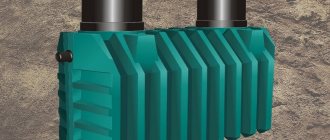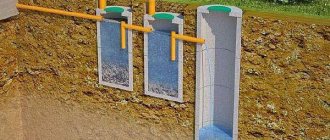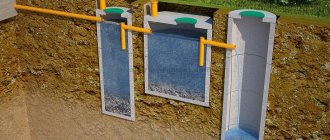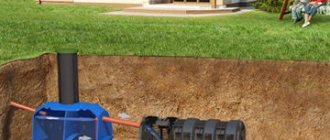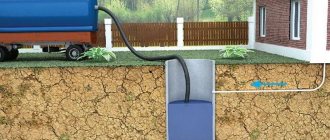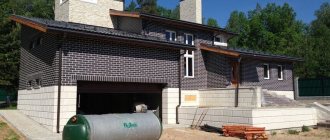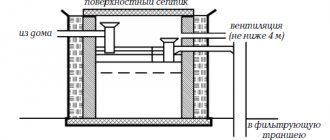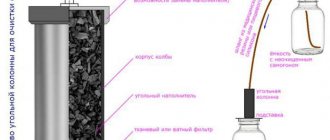If we consider the design of a septic tank, then the design diagram and operating principle of various models have much in common. Most treatment facilities are connected reservoirs for step-by-step water purification and sedimentation of insoluble organic and mineral inclusions. Chambers can be made of different materials (Eurocubes, concrete rings, car tires, brickwork, etc.), and differ in shape (round, rectangular, vertical, horizontal). They can be free-standing tanks (this option is convenient when used for the construction of finished products) or one tank with a waterproof partition (such a device is advisable when constructing poured concrete walls).
Design elements
Many septic tanks have a mechanical filter to sediment sediment during the cleaning process. A mechanical filter involves sedimentation of particles without any chemical reaction or introduction of reagents. In septic tanks, wastewater is filtered through a layer of sand, expanded clay or gravel, and in some cases, after leaving the tank, additionally through a layer of soil.
Please note: If it is impossible to drain treated wastewater into the soil in septic tanks located in clay soils, pump pumping into an irrigation tank or drainage ditch.
An exception to the rule may be a single-chamber septic tank device, the operating principle of which does not allow for the gradual sedimentation of large and small fractions and filtering of wastewater. Such devices work only as storage devices. They compare favorably with cesspools in the impermeability of the walls and bottom, but have similar functionality. The single-chamber model is a completely waterproofed septic tank - the installation diagram does not provide for the presence of a filter bottom.
The main elements of all septic tanks are:
- chambers for settling water (in some models, sediment is processed in the chambers),
- pipelines at the inlet and outlet (the latter may be absent if treated wastewater is drained into the ground through the bottom),
- ventilation system,
- maintenance devices (hatches, inspection wells).
The photo shows a diagram of the installation of a septic tank from three chambers with soil post-treatment of wastewater on a filtration field.
The principle of operation of a septic tank is based on the flow of wastewater through communicating vessels (chambers) from one to another with a gradual decrease in the amount of impurities and clarification of the water.
General principle of operation of the treatment plant
The functioning of any septic tank is based on the principles of gravitational settling and biological filtration using a natural or forced method. It is possible to use bioenzyme preparations and biofilters. Conventionally, the sequence of sewage treatment can be divided into several standard stages.
Stage 1. Primary cleaning . The sewer pipe from the house carries wastewater into the first tank or compartment. Here a rough cleaning of suspended large particles occurs. Heavy suspensions (grains of sand and similar insoluble waste inclusions) settle to the bottom of the chamber. Light fractions (fats and oils) rise to the surface and flow into the next compartment.
Stage 2. Decomposition of heavy particles . The waste that has sunk to the bottom of the first chamber begins to ferment and decompose - the process takes about 3 days. As a result, sewage breaks down into a thick mass, carbon dioxide and water.
Sludge accumulates at the bottom of the first compartment, which must be removed periodically. The efficiency of liquid purification in the first chamber is about 60%. This is not enough for disposal into the ground, so additional treatment is required (+)
Stage 3: Re-cleaning . In the second chamber, the waste is re-decomposed. In some septic tanks, at this stage, due to the action of special bacteria and preparations, chemical (personal hygiene product waste) and organic compounds break down.
Stage 4. Liquid removal . The further path of the water depends on the type of treatment system. The purified liquid can flow into the reservoir for subsequent watering of the garden.
If the degree of purification is insufficient, then the water must undergo a further purification process through infiltration, a drainage well, fields for ground filtration, etc.
Image gallery
Photo from
Septic tank with filter well
Filtration field in a suburban area
An improved version of the filter field
Drainage pipes in the filter trench
A schematic description of the traditional operating principle of a septic tank conveys the general features of the process. Each modification of the treatment plant has design and operational nuances.
Advantages of septic tanks
From an operational point of view, the main advantages of septic tanks are:
- less need for cleaning with the help of a sewer service (for models “without pumping” the frequency reaches 10-15 years),
- the possibility of drainage or use for irrigation of water that is clean and safe from the point of view of sanitary requirements and ecology,
- no unpleasant odor.
In most cases, the efficiency of septic tanks is ensured by the presence of bacteria in the tanks, which convert difficult-to-decompose impurities into sludge. As a result of the vital activity of microflora, impurities are converted into gas, which is removed through ventilation outlets, clean water and insoluble sediment.
The bacteria working in septic tanks can be aerobic or anaerobic.
- The former require air flow, so they are used only in energy-dependent models with compressors. They are more efficient and provide high quality and speed of wastewater treatment. At the same time, such models are characterized by a more complex septic tank design.
- The latter are inferior in efficiency, but their use does not require the use of any technical means. Crops purchased at a specialized store can be added even to single-chamber septic tanks through the sewer. In storage models and in models with drainage of purified water, bacteria make it possible to increase the length of the period between pumpings.
Existing types and classification
Depending on the volume of wastewater flow, single-chamber septic tanks (up to 1 m³ per day), as well as two-chamber structures (up to 10 m³ per day) and three-chamber devices (more than 10 m³ per day) are distinguished.
Among other things, different types of autonomous sewage systems differ markedly in the method of wastewater processing and the purity of recycled water; they can be energy-dependent and overflow, and are also made of different materials.
Aerobic and anaerobic are autonomous wastewater treatment systems, which differ from each other only in the bacteria involved in the processing of sewage water.
In the first case, the wastewater is treated in the presence of oxygen, which enters through the vents or is delivered by a compressor and aerators.
All anaerobic septic tanks function due to the microbiological decomposition of the organic component by bacteria in an oxygen-free environment.
Deep treatment facilities are aeration installations for processing wastewater, which can be discharged onto the terrain and, if UV disinfection is available, into water bodies.
In separate chambers of such structures, aeration devices are installed that saturate the wastewater with oxygen using compressors. There is no need to develop a special area for soil post-treatment of discharged water.
The average price is 102 thousand rubles (Eurobion-8 PS model).
Septic tanks with soil post-treatment belong to the category of anaerobic plants. The efficiency indicators of oxygen-free decomposition of wastewater are not high enough, so a two- or three-level treatment option with additional treatment in the soil should be used.
Such post-treatment can only be used on fairly well-filtering sandy loam and sandy soils, characterized by a low level of water passage. The average price is 55 thousand rubles (model ROSTOK Cottage).
Non-volatile septic tanks are characterized by completely autonomous operation, quite affordable cost, ease of installation and maintenance during use, and the absence of complex devices in this design allows the structure to be used for a long time.
Non-volatile models do not need to be preserved for the winter, but soil post-treatment of recycled wastewater is mandatory. The average price is 59 thousand rubles (Kedr septic tank).
Overflow septic tanks are quite simple in design. Such autonomous wastewater treatment systems are represented by several separate containers connected to each other through plastic pipes, which ensure the unity of the design.
High quality sewage treatment in overflow systems is achieved by combining several filtration options. The average price is 32 thousand rubles (Eurolos ECO-3 model).
Septic tanks made of concrete rings are a budget-friendly and quite worthy option for creating an autonomous sewer system with your own hands.
In such facilities, sewage wastewater treatment is carried out by microorganisms. Installation of a pair of cleaning chambers is necessary when serving several users, but the level of wastewater treatment is not high enough. The average price is 45-50 thousand rubles (two tanks with 4 rings each).
Plastic ready-made septic tanks are popular treatment facilities, characterized by their affordable cost, durability, guaranteed tightness, simplicity and ease of maintenance. Such models cost consumers less than concrete septic tanks, but independent installation and subsequent operation require compliance with certain rules and regulations.
Plastic storage tanks are optimally suited for arranging sewage systems for seasonal living in suburban conditions. The average price is 90 thousand rubles (Evo Stok Bio model).
Monolithic concrete septic tanks have guaranteed impermeability and absolute tightness, can be installed in areas with any groundwater level, and also have an increased capacity.
During operation there are no odors or noises, which is due to the complete soundproofness of the housing. The structure does not need to be preserved for the winter and operates autonomously, and standard cleaning of the tank is carried out every one and a half to two years.
The average price is 60 thousand rubles (model “Favorit 2P”).
All single-chamber septic tanks have the simplest possible design and have a volume that is a multiple of the daily discharge. In terms of functionality, such autonomous wastewater treatment facilities are noticeably inferior to multi-chamber septic tanks, and therefore are used most often for the purpose of seasonal operation.
Single-chamber storage tanks can be sealed or drainage type, and the main disadvantage is the need to pump out accumulated sediment quite often. The average price is 65 thousand rubles (Tver model).
Two-chamber septic tanks are represented by a pair of settling tanks, and the bulk of all sediment settles in the first chamber, which helps prevent secondary contamination of clarified waters with decay products. Some models have a filter installed in one of the chambers, which increases the level of wastewater treatment.
The operating principle of aerobic septic tanks with biotreatment
Aerobic septic tanks are multi-chamber treatment structures. The operating principle of this type of septic tank is the use of microorganisms that require oxygen , which contribute to the rapid and effective decomposition of impurities. As a result, clean water, gas and sludge are formed, which are removed through special hatches. The biopurification stage is preceded by sedimentation of the largest inclusions in the storage chamber.
Aerobic septic tanks with biotreatment are often called deep purification stations. At the output, they provide cleaner water (up to 98% removal of impurities), and the cycle of sedimentation and decomposition of impurities in them is significantly less than in other types of models.
The operating principle of a septic tank with deep biological treatment allows for the further use of purified water for technical needs
Due to the need to ensure a constant flow of air, all aerobic septic tanks are energy dependent , and their design and operation require additional funds (electricity costs), however, careful calculations prove the return on investment of such investments with constant use.
When operating aerobic septic tanks with biotreatment, the following recommendations should be observed:
- A colony of microorganisms that process impurities may die if a large amount of disinfectant or antiseptic is poured down the drain.
- The death of microorganisms can also be caused by a break in operation, so models of this type are more suitable for houses with permanent residence than for summer cottages.
Tips and tricks
When designing a septic tank, you need to determine its working volume as accurately as possible. If it is assumed that the amount of sewerage may increase over time, then it is better to choose a volume with a small margin. Then it will be possible to avoid overload in the future when it begins to work inefficiently.
During operation, special microorganisms are used that promote the decomposition of waste waste and, thereby, significantly improve the quality of treatment.
It is necessary to ensure that foreign objects that clog the system, such as cotton swabs, hair, water-insoluble paper, etc., do not enter the sewer pipes.
It is better to purchase the highest quality materials for the septic tank, because otherwise such savings can lead to very negative consequences that will have to be eliminated and the work done again.
It would be optimal to design a septic tank at the level of building a house, when all the details of its location can be foreseen and all sorts of difficulties can be avoided.
This design will be a solution to the problem of removing sewage and cleaning it if there is no connection to the central sewer system. If you temporarily live outside the city only in the summer and on weekends, it will be enough to install storage tanks, which do not require special care.
A non-volatile design or a local treatment plant operating on electricity requires approval of the installation from the state sanitary and epidemiological supervision, from which it is necessary to obtain a design reference before installation.
Knowing how to properly install a septic tank in a private house and having implemented this, the owner of a country house will ensure the normal functioning of the sewage system in it, which will significantly increase the comfort of living outside the city.
The operating principle of anaerobic septic tanks with mechanical cleaning
Anaerobic septic tanks mainly use the principle of mechanical treatment (sedimentation and filtration). To increase efficiency and to extend the intervals between tank cleanings, cultures of anaerobic (not requiring air) bacteria can be added. However, they do not decompose impurities as actively as aerobic cultures.
How a three-chamber septic tank with gravity cleaning and filtration through a drainage well works is shown in the diagram
The quality of filtration is of great importance in the operation of anaerobic septic tanks with mechanical cleaning. The thickness of the filtration layer, the size of its particles, the speed of passage of water, the method of removing the purified liquid (directly through a bottom filter or through a filtration field formed by horizontally located underground pipes) - all this affects how the septic tank works.
Materials for the construction of chambers
You need to start building a two-chamber septic tank with your own hands by choosing the material for the chambers. In addition, you need to draw up a diagram of the overflow septic tank, and also think about the organization of post-treatment.
These can be filtration fields or an infiltrator. Both of these devices use the same operating principle. Once on the filtration fields, the liquid is filtered mechanically and purified biologically (the principle of aerobic biopurification is used).
Let's start with choosing the material. When constructing septic tanks that do not require frequent pumping, it is advisable to use the following materials with your own hands:
- Reinforced concrete. There are two options here: purchasing ready-made well rings or building a monolithic septic tank. Having chosen the option with rings, you will need to take time to seal the chambers at the joints of individual elements. In addition, such a septic tank is difficult to build with your own hands; the use of lifting equipment will be required.
- Brick. If a home craftsman has experience in bricklaying, then he can build brick chambers quite quickly.
Advice! When choosing brick as a material for constructing a septic tank, it is necessary to take a certain type of material, namely clinker. This type of brick is made from baked clay, so it is not destroyed by water. But it is not advisable to use ordinary porous or silicate bricks.
- Plastic. If the master has ready-made plastic containers of the required volume at his disposal, then the construction of a septic tank will be extremely simple and convenient. Most often, Eurocubes are used to construct chambers.
Advice! For example, when building a septic tank with your own hands, using a metal tank or barrel as a chamber is not the best choice. Even with careful anti-corrosion treatment, such a structure is unlikely to last more than 5-6 years.
Model selection
The choice of tank volume, number of chambers and operating principle of a septic tank for a summer residence and for a home largely depends on operating conditions. The functionality of a treatment facility at a dacha, where people come for a few hours or days, differs from how a septic tank works in a private house with a shower, kitchen, toilet and water-consuming household appliances (washing machines, dishwashers, etc.).
In a house with permanent residence, not only is the volume of wastewater larger, but its composition is also more complex, which includes both organic and chemically active substances. In this case, it is important to ensure the possibility of high-quality cleaning for drainage into the ground, so that you do not have to constantly call a sewer truck. Investment in the purchase of an effective aerobic energy-dependent septic tank and the costs of its operation in this case will pay off. But during breaks in operation at a summer cottage, bacteria can die.
We talked about what products are available for septic tanks and cesspools in another article. Features of the use of chemical and biological drugs.
You will learn how to make a wastewater treatment plant from Eurocubes yourself by reading this article.
You will find a review of models of peat country toilets here https://okanalizacii.ru/postrojki/tualet/torfyanoj-tualet-dlya-dachi-kakoj-vybrat.html
Construction and installation of a country septic tank from monolithic concrete with your own hands
When performing concrete work during the construction of a septic tank for a summer residence, you need to use a site plan and a diagram of the internal structure of the tank (number of sections and installation order).
Sequence of installation work:
- We mark the supply trenches and pit. The boundary of the area for the tank should be 200 mm larger than the dimensions of the tank.
- We carry out earthworks. The trench under the supply pipe is dug with a slope to the horizontal surface of at least 2%. A sand bedding 150 mm thick is made along the bottom of the excavation.
- We are preparing reinforcement mesh and formwork panels.
- Along the bottom of the pit we arrange a crushed stone-sand cushion 150-200 mm high.
- We lay the reinforcement frame on the prepared site, and install the formwork around the perimeter under the bottom of the septic tank.
- We make a concrete mixture or, if the volume allows, we take a ready-made one.
- We lay the solution.
- We compact the layer with a vibrator.
- We wait 72 hours and remove the formwork.
- On the bottom of the tank we mark the diagram of future walls and partitions. The thickness of the walls is 200 mm, the thickness of the bulkheads is 150 mm.
- According to this plan: we arrange the panels for the walls and lay the reinforcement frame inside. The height of the fence should be no more than 1 m. In this case, it will be convenient to compact the mixture with an internal vibrator. Don’t forget to place steel or plastic sleeves in the formwork under the inlet and outlet pipes, and leave holes in the partitions for overflow and ventilation.
- Pour the mixture into the structure.
- We give time to the concrete to gain the necessary strength and move the formwork up to the next section.
- Laying the mortar continues until the walls reach the design mark.
- To cover the septic tank, you can use a prefabricated reinforced concrete slab with an already equipped hole for the hatch or continue laying monolithic concrete in the same sequence as pouring the solution into the main part of the structure.
- Upon completion of installation work, we install underwater and outlet pipes, equip a ventilation duct and waterproof the walls and ceilings.
- We backfill the pit. The soil is laid in layers (200-350 mm) with mandatory compaction using special devices.
Important nuances
Since the principle of operation of a septic tank is based on the gradual sedimentation of impurities, the efficiency of its operation and the absence of impurities in the purified liquid depends, among other things, on the speed of water flow from one tank to another. A fast flow will not only impede the movement of sediment towards the bottom, but will also raise the silt that is already there.
It is extremely undesirable for inorganic substances with a very long decomposition period to enter the septic tank. It is important to ensure that polyethylene, plastic, etc. do not get into the sewer.
The diagram of the septic tank and the principle of its operation is shown in the video.
A variety of models of budget septic tanks for a summer residence without pumping: overview, characteristics, cost
The modern market offers a wide selection of sewer treatment systems from domestic and foreign manufacturers. The functionality of the models, their design and performance may vary significantly, so the user must first decide for what purpose and for what purposes he is purchasing a drain cleaning system.
Septic tanks of various models and modifications are available to the user.
If we are talking about a septic tank for a temporary residence for two people, then it can be an inexpensive two-chamber model with a capacity of up to 200 l/day. If the question is about a system for a country cottage for a large family, which also loves to receive guests, then the productivity of the product and its volume should increase to the appropriate level.
Based on this, when choosing septic tanks for a dacha without pumping, which one is better can be determined by technical characteristics, material of manufacture, used cleaning schemes, the presence of post-treatment systems and, of course, the cost of the product.
It is difficult to make a choice from a huge number of offers
Practical advice! When deciding to purchase a septic tank, you need to assume a possible increase in water consumption, and, accordingly, an increase in the level of domestic and household wastewater. Therefore, it is recommended to buy a product with a volume slightly larger than required for a given period of time. This will help avoid subsequent rebuilding and retrofitting of the existing system.
Price of septic tanks for a private house: description, analysis, comparison
Cost and its compliance with the practicality, reliability and functionality of the product plays an important role when deciding in favor of one or another product. In order to study the pricing situation around sewer treatment systems, the user is invited to familiarize themselves with some models, their descriptions and costs:
| Image | Name, brief description of the product | Price range, rub. |
| BCS, 3-chamber design with a biofilter. Capacity: from 250 to 2000 l/day | From 20000 to 115000 |
| “Dochista”, has 2 chambers, provides for the possibility of using additional post-treatment systems, productivity from 800 to 1800 l/day | From 26000 to 100000 |
| Clean S-5 | ||
| “Leader”, three cleaning chambers, a compressor with an aerator installed, capacity 200–3600 l/day | From 71000 to 200000 |
| “Rostock”, 2-chamber design with the possibility of using a biofilter for post-treatment. Capacity 250-2000 l/day | From 25000 to 45000 |
| Country sprout | ||
| “Tank”, has 3 chambers, can be equipped with a biofilter, infiltration system, capacity 150-1800 l/day | From 20000 to 60000 |
| “Termite”, a 3-chamber model, provides the possibility of using a post-treatment system. Capacity 700-2000 l/day | From 26000 to 83000 |
| Septic tank Termite pro | ||
| "Chistok" is equipped with 2 or 3 cameras. May have a biofilter and aerator. Capacity 650-3000 l/day | From 32000 to 116000 |
| "Unilos", a 3-chamber septic tank, equipped with a compressor with an aerator, has a capacity of 600-3000 l/day | From 60000 to 160000 |
| Unilos Astra-10 | ||
These price values are average indicators of the cost of products in online stores, and therefore cannot reflect the real situation on the market and can be used to draw up estimates for the installation of sewer treatment systems.
Related article: Which is the best septic tank for a summer residence? After reviewing the information provided, you can get a more complete understanding of the structure of your home sewage system and wastewater treatment system and consciously begin choosing the design of a treatment facility.
